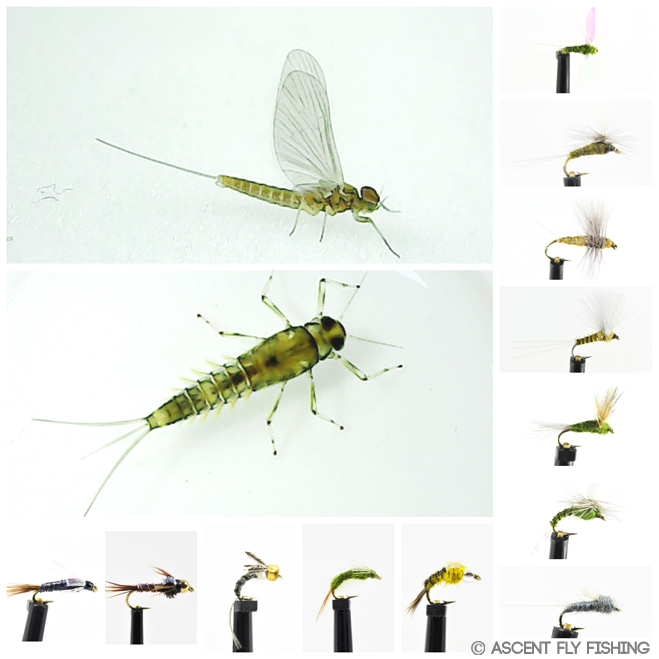A Fly Fisher's Guide to Identifying and Matching Mayflies: Part II
Posted by Peter Stitcher on 15th Jan 2017

The importance of the mayfly in the diet of trout cannot be overstated. In my work as an aquatic biologist studying and sampling trout waters across country, I've seen populations of Blue Winged Olive mayfly nymphs crowding Rocky Mountain streams topping numbers of 1,200 nymphs per square meter, slow moving herds of green drake nymphs covering the bottoms of summer streams like the buffalo herds of days gone by, and the Hex hatches rise late each Spring to blot out the moon over the great lakes. Trout will actively track and target mayflies through their entire life cycle, picking nymphs from among the rocks, chasing after emerging mayfly nymphs as they frantically swim towards the surface, and greeting the mayfly spinners with open mouths as they return to the water to lay their eggs and die. Coming from waters crowded with mayfly species and walking into a fly shop with battalions of fly displays lining the walls can overwhelm even the most seasoned angler. For those looking to simplify matching mayflies through their life cycle, look no further than our Deadly Dozen Mayflies. By changing up the size and color of these proven patterns, the fly fisher can match a multitude of mayfly species across the county, becoming a force to be reckoned with and feared by trout wherever they wet a line!
Mayfly Nymph Patterns
Mayfly nymphs patterns are typically tied to straight shank hook in sizes 12-22, but can be tied to hooks as large as a size 6. Accounting for 99.9% of the life of the mayfly, nymph patterns are four-season trout favorites and will be effective on both lakes and rivers at every elevation. Nymph patterns usually have a tightly wrapped thin profile, include hair or pieces of feather that imitate a tail and legs, and often incorporate metal bead heads and wire ribs to help the fly sink.

Dry/Wet: Wet
Fly Category: Generalist Pattern
Color: Natural, Olive, Black
Life Cycle: Nymph
Hook Size: 12-22

BH Flashback Hares Ear
Dry/Wet: Wet
Fly Category: Generalist Pattern
Life Cycle: Nymph
Hook Size: 12-22

BH Prince Nymph
Dry/Wet: Wet
Fly Category: Attractor Pattern
Life Cycle: Nymph
Hook Size: 12-20

BH Rainbow Warrior
Dry/Wet: Wet
Fly Category: Attractor Pattern
Life Cycle: Nymph
Hook Size: 12-20
Emerging Mayfly Nymph Patterns
Imitating one of the most vulnerable life cycles of the mayfly, trout eagerly pursue and feed upon the emerging mayfly nymphs in the journey between the sanctuary of the streambed and the refuge of the air. Often tied to a curved shank hook to better match the swimming profile of the nymph, emerging nymph patterns may also include some material tied to the back to imitate the wings of the dun starting to poke through the shuck.

Greg's Emerger
Dry/Wet: Wet
Fly Category: Generalist Pattern
Color: PMD, Olive, Grey, Black
Life Cycle: Emerging Nymph
Hook Size: 14-22

Chocolate Thunder
Dry/Wet: Wet
Fly Category: Generalist Pattern
Life Cycle: Emerging Nymph
Hook Size: 18-22

Sparklewing RSII
Dry/Wet: Wet
Fly Category: Generalist Pattern
Color: Grey, Olive, Black
Life Cycle: Emerging Nymph
Hook Size: 18-22
Emerging Mayfly Dun Patterns
Suspended half in and half out of the water, the emerging mayfly dun pattern imitates the mayfly as it transitions from wet to dry life cycles. The wings of these patterns are usually reduced in size while a clump of yarn off the back imitates the skin of the nymph being left in the surface of the water as the adult dun struggles into the air. This is the last chance for the trout to grab a mouthful of mayfly until they return to the water in their spinner life cycle.

Sparkle Dun
Dry/Wet: Dry
Fly Category: True-Fly Pattern
Color: BWO, Trico, PMD, Sulphur, Green Drake
Life Cycle: Emerging Dun
Hook Size: 12-22
Mayfly Dun & Spinner Patterns
Matching the sailboat-like profile of the natural with their wings held tall above their back, the defining characteristic of mayfly dun and spinner patterns are the parachute, split-wing, and comparadun-type wings tied perpendicular to the shank of the hook. While only lasing 4-48 hours, trout will gorge themselves on the dun and spinner mayflies as they cover rivers and lakes in some of the most prolific and anticipated hatches of the year.

Parachute Adams
Dry/Wet: Dry
Fly Category: Generalist Pattern
Life Cycle: Dun or Spinner
Hook Size: 12-22

Royal Wulff
Dry/Wet: Dry
Fly Category: Attractor Pattern
Life Cycle: Dun or Spinner
Hook Size: 12-18

Light Cahill CDC Comparadun
Dry/Wet: Dry
Fly Category: Generalist Pattern
Life Cycle: Dun or Spinner
Hook Size: 12-18
Spent Spinner Patterns
After mating in flight, the male spinners will rain down across the lake or river followed soon after by the females who expire immediately after depositing their eggs through the surface of the water. In death, their once-proud wings relax at their sides, laying flat on the surface of the water. The carcasses of spent spinners are then gathered by the current as they bump downstream, creating clumps of mayflies that can entice even the most reluctant trout for one final rise.

Rusty Spinner
Dry/Wet: Dry
Fly Category: Generalist Pattern
Life Cycle: Spent Spinner
Hook Size: 16-20
You don't need to stock every hot new mayfly pattern pushed by the local fly shop. When in doubt or looking for some go-to mayfly patterns, look no further than the deadly dozen mayflies, and get ready for tight lines!

